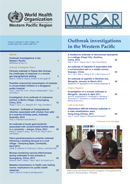Mumps-containing vaccine effectiveness during outbreaks in two schools in Guangdong, China, 2012
DOI:
https://doi.org/10.5365/wpsar.2012.3.4.012Abstract
Introduction: Mumps-containing vaccine was licensed in the 1990s in China with a single dose administered routinely to children aged 18-24 months since 2008. However, an increase in reported mumps cases during the period 2009 to 2012 casts doubt on the effectiveness of a single-dose mumps vaccination. In March 2012, large numbers of mumps cases in a day-care centre and primary school in Guangdong Province were investigated to estimate the effectiveness of mumps-containing vaccine.
Methods: A mumps case was defined as a case with acute onset of unilateral or bilateral swelling of the parotid gland or other salivary glands. Clinical data were collected among students and staff members in the two schools from 6 February to 3 June 2012. Vaccination history was obtained from immunization certificates. Vaccine effectiveness (VE) was calculated among children in classes that had more than two mumps cases.
Results: The cohort included 369 children from seven classes, four from the day-care centre and three from the primary school. Vaccination certificates available for 347 children showed immunization coverage of 82% (285/347). The overall attack rate was 14.6% (54/369); the VE for a single dose of mumps vaccine was 65% (95% confidence interval [CI]: 19%-85%) when given within three years and 15% (95% CI: -2%–52%) when given three to six years before the outbreak. For two doses of vaccine the VE was 53% (95% CI: -15–80%).
Discussion: A single dose of mumps-containing vaccine was not effective to prevent these outbreaks among preschool and school children. A second dose of mumps-containing vaccine to four to five-year-old children should be considered in China.

